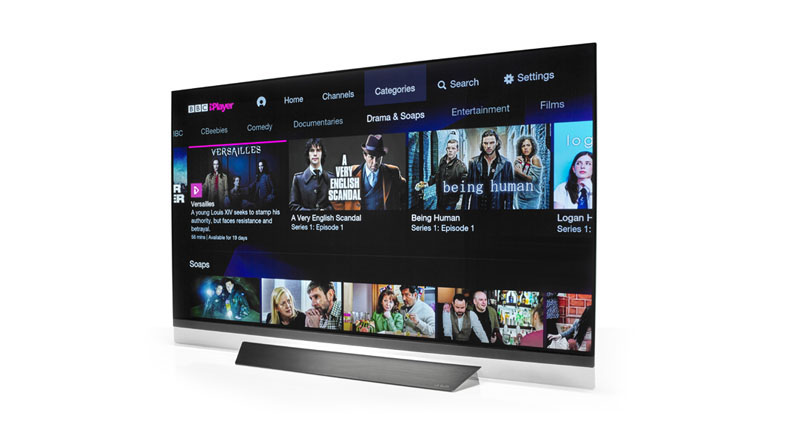What Hi-Fi? Verdict
The OLED55E8PLA is another stunning 2018 LG TV, even if it isn’t the very best value for money model in its line-up
Pros
- +
Class-leading picture
- +
Gorgeous design
- +
Well-equipped smarts
- +
Useful ThinQ features
- +
Easy to use
- +
Comprehensive picture mode options
Cons
- -
Doesn’t justify premium price
Why you can trust What Hi-Fi?
The LG OLED55E8PLA has a battle on its hands. Not just against televisions from competing brands, such as the five-star Samsung QE55Q9FN and Sony KD-55A1, but it also faces an internal struggle against rivals from the same LG OLED stable.
With LG’s C8, E8, G8 and W8 OLED ranges featuring the same OLED panel and Alpha 9 picture processor (only the entry-level B8 OLED series still uses a lower-spec processor), any major discrepancies between them tend to be less related to picture performance, and more to do with arguably more mundane qualities, such as physical design and sound enhancements.
The OLED55E8PLA is the 55in variant in LG’s new E8 range, and the most advanced of its size in the brand’s 2018 line-up (the G8 and W8 ranges start at 65in). In terms of the LG hierarchy, the E8 sits above the OLED55C8PLA that we recently gave a five-star review to.
So what’s the difference between the two? The E8 has a built-in soundbar, as well as a ‘picture-on-glass’ design over the C8’s more traditional ‘blade slim’ stand. But the main distinction would appear to be the price.
The E8 costs £500 more than its C8 equivalent, so does it put forward a solid case for the additional cost?
MORE: What is OLED? The tech, the benefits, the best OLED TVs and OLED phones
Build
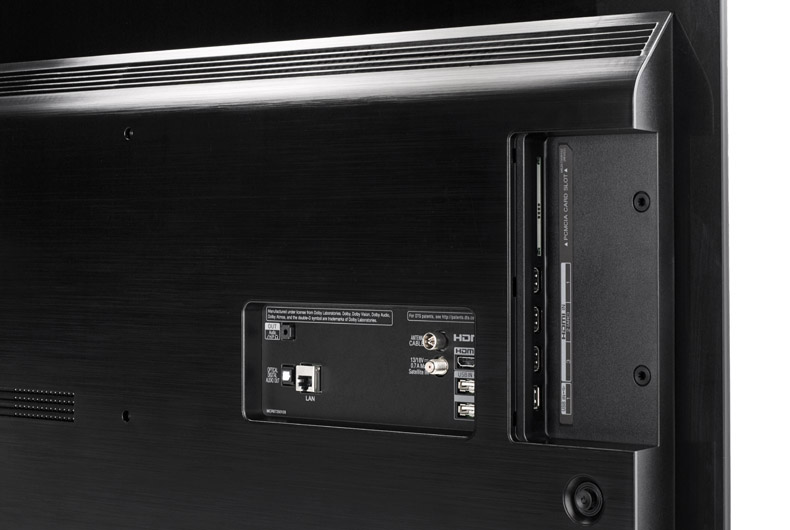
Round the back of the E8 there are a host of inputs catering for various hardware sources. These include four HDMI inputs – three side-facing and one rear-facing – all of which allow 4K and HDR pass-through.
There’s also a pair of USB sockets on the back and one on the side, an ethernet socket for an alternative to wi-fi, and an optical output for connecting to a soundbar or soundbase.
MORE: OLED vs QLED - which is the best TV technology?
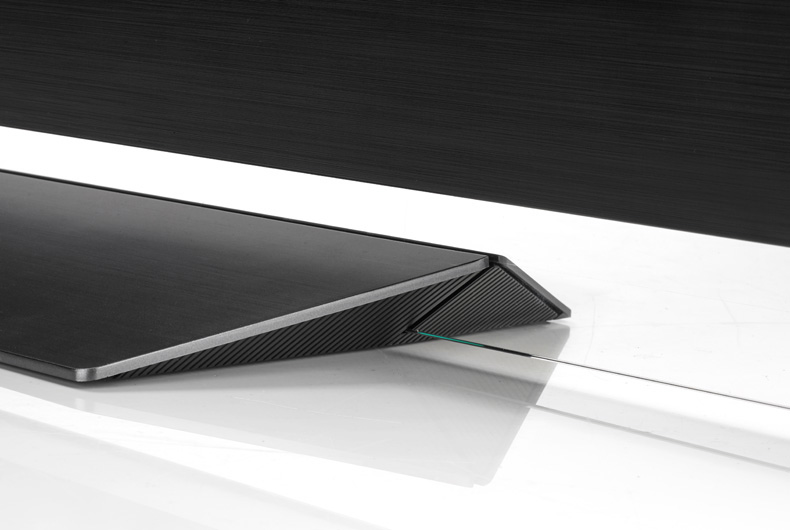
The major design talking point is the stand, which we can’t say for many TVs. Below the screen and strip of speakers is a glass panel into which the trapezoidal-shaped ‘alpine stand’ can be slotted, giving it an artistic, floating appearance.
The stand enhances the overall elegance of the TV’s thin frame, metallic-finished stand and gyroscope-sensor smart remote.
Picture
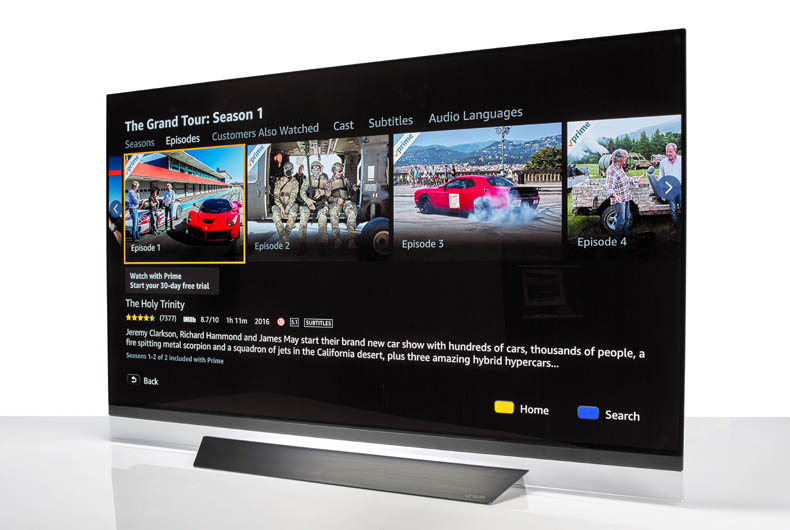
In the lead up to LG’s TV unveiling at the start of the year, the company claimed its new Alpha 9 processor would bring improvements in noise reduction, sharpness and colour reproduction over last year’s sets.
This, it said, would minimise banding, draw details more distinctly and enhance depth and colour accuracy.
And credit where it’s due, claims of ‘the most powerful picture processing ever made by LG’ turn out to be pretty convincing. The OLED55E8PLA is, like its sibling, an undeniable triumph in picture quality, and a notch in LG’s belt.
We play Paddington on 4K Blu-ray through the OLED55E8PLA, and the movie reveals the potential of the LG TV. It is so squeaky-clean, sharp and clear that there’s almost a glassy quality to the picture.
MORE: 4K Ultra HD Blu-ray – all the discs on sale and coming soon
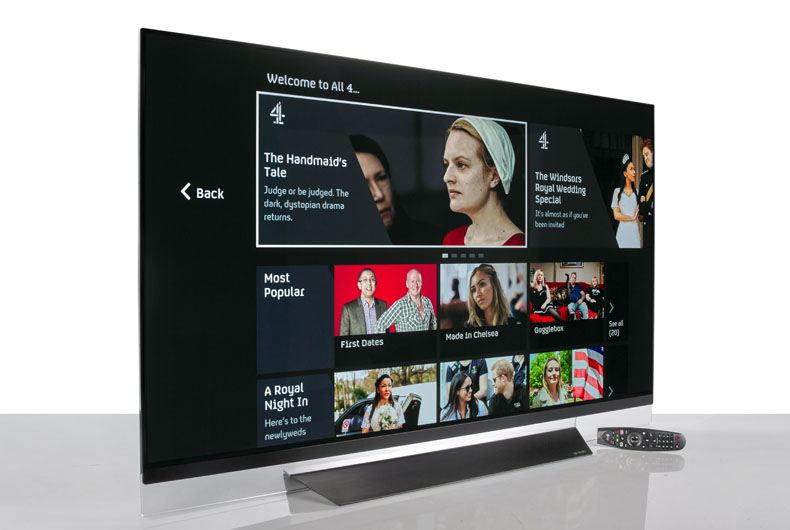
Scrutiny of the 4K, Dolby Vision HDR material seems almost effortless, from its colour range and definition to its judgement of contrast and astute display of detail.
The way it highlights textures in Hugh Grant’s costumes and Paddington’s bear fur is splendid. It also captures the shadows on the actors’ faces well, and balances punch and refinement when it comes to communicating the film’s vivid colour palette, from the resplendent yellows and golds in the antique shop to the red of Paddington’s hat.
Thanks to the rich contrast for which we often praise LG TVs, candles glow radiantly in the dark church, while fairground lights are bright against the night sky, with minimal banding.
However, the LG doesn’t quite match the five-star Samsung QE55Q9FN for absolute punch and brightness – something we also noted in our review of the C8, but it's still a hugely accomplished picture.
MORE: Dolby Vision HDR – everything you need to know
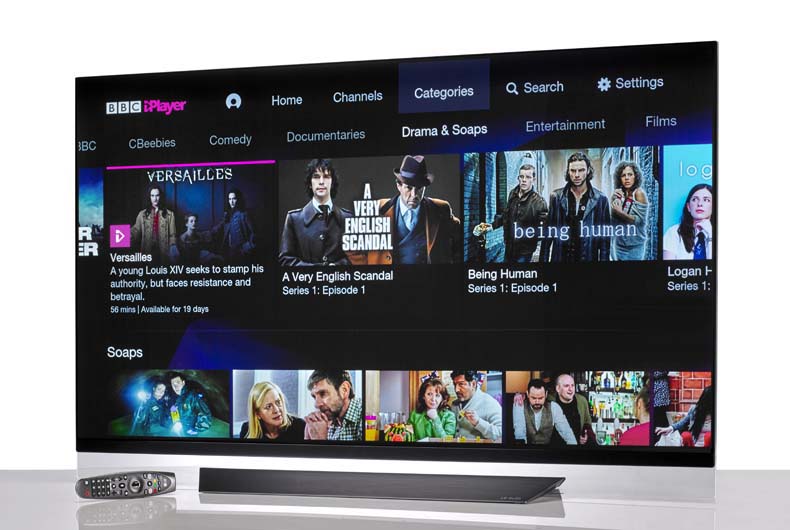
If anything, its comparatively subtle quality, while not as eye-grabbing, is more realistic. A superior depth of blacks offsets any potential downside too.
Playing the crime drama Dark via Netflix, the LG captures the discrepancies in light and dark areas of a frame better – when sunlight hits a house or shines through a sunlight in a room, for example.
The show has a mostly drab urban palette, which is lapped up by the LG’s grounded handling of colour.
It identifies numerous shades of greens and browns in the autumnal Black Forest, but at the same time it exposes the vibrancy of a bright yellow mac against the grey tarmac road and the reflections off the latter.
As with most TVs, getting the best picture performance from the E8 requires a little work. In our review of the C8, we decided LG’s Cinema Home mode was preferable for HDR content, with Standard our go-to for everything else.
MORE: HDR TV – What is it? How can you get it?
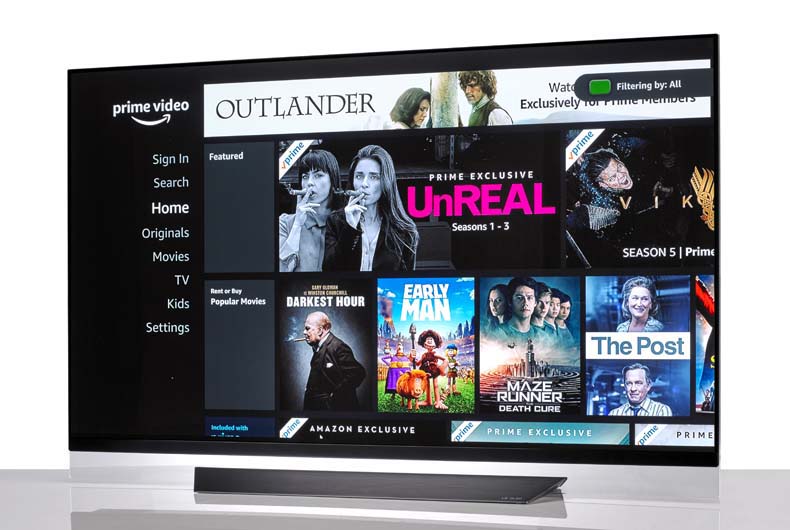
And considering LG’s panel and processing smarts are the same, it’s not surprising to find those preferences working best here too. We try some lower resolution material in the form of The Jungle Book in Full HD, but dropping down the pixel count doesn’t spell the end of our enjoyment.
The impressive ability of the LG’s upscaling makes it easy to forget we’re watching an inferior resolution. In the opening scene, jungle greens are potent yet subtle, details in the animals are fine, and the motion handling as Mowgli jumps from tree to tree remains stable.
With some high frame rate (HFR) support, the 2018 LG OLEDs could be the gifts that keep on giving, when HFR content is available. We also await more content in Hybrid Log Gamma, the HDR format supported by the LG, in addition to HDR 10, Dolby Vision and Advanced HDR by Technicolor.
MORE: Hybrid Log Gamma explained – the new HDR TV broadcast format
Sound
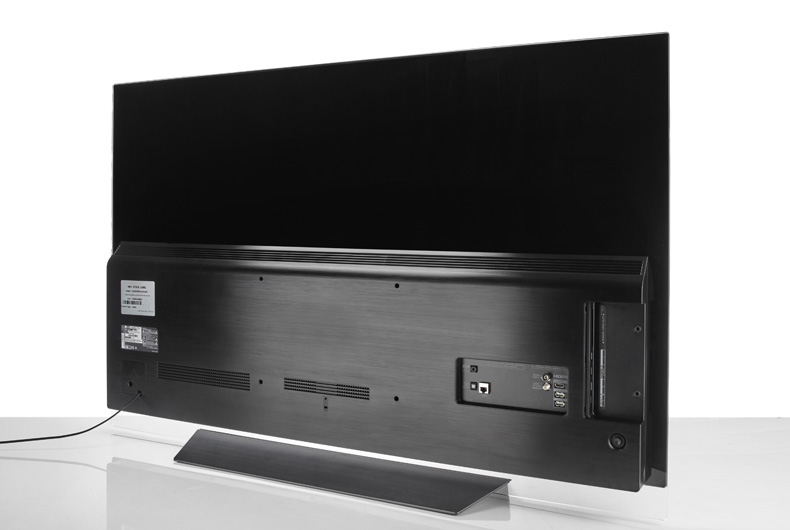
Part of the extra cost can be justified by the OLED55E8PLA’s enhanced sound capabilities. With a speaker running underneath the screen for its entire length and support for Dolby Atmos, LG can rightly shout about its sonic effort.
From the sharp, ominous burst of sound throughout the darker moments of Dark, to fluttering of instrumentals in the score of Paddington, the E8 offers a perfectly listenable experience that has the ability to reach impressively loud levels without losing its rounded balance.
MORE: Dolby Atmos – What is it? How can you get it?
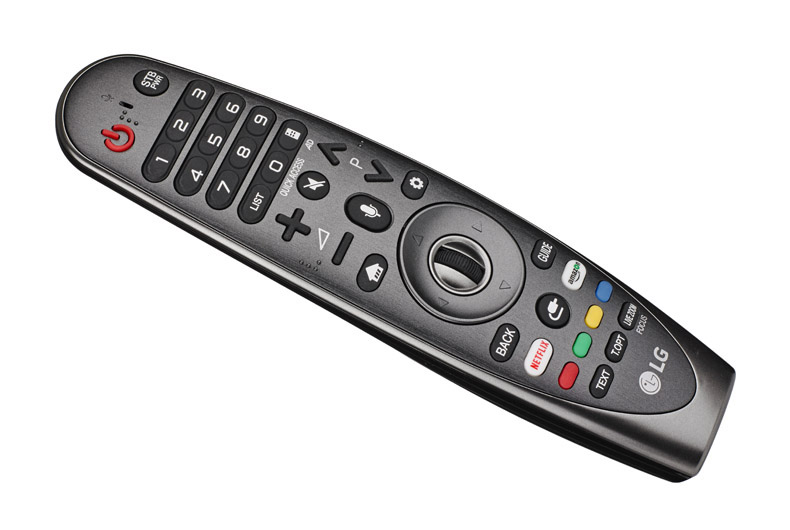
We play Mastersystem’s The Quay Sessions via iPlayer, and while it feels quite restrained in absolute musical terms – you don’t get the full impact of the drums, nor the emotional pull usually attached to a live performance – it’s enjoyably clear and tonally sound.
The gains in body and clarity overcome the shrill and tinny sound typically associated with TVs, but as you’d expect from speakers only a few centimetres wide, they can’t match the dynamics, bass presence or breadth of sound of external speakers.
So, despite the above-par audio performance, we’d still recommend a soundbar or surround-sound set-up to accompany a TV of this calibre.
It’s good to see manufacturers taking sound quality seriously, but it still may only be a reason to delay, rather than completely put off, the inevitable.
Features
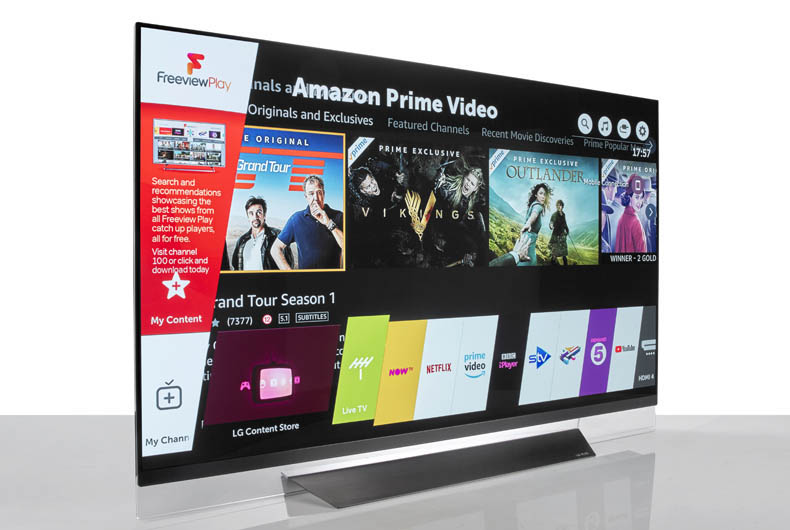
This is the fourth year LG has used its WebOS platform and there are no major changes for its 2018 TVs, which isn’t necessarily a bad thing.
Logical navigation, slick operation and a comprehensive suite of smarts (including 4K-and HDR-supporting Netflix and Amazon, Freeview Play and Rakuten TV) all make for an intuitive experience – even if it doesn’t have the flashiest of interfaces, nor the most inviting of menus.
LG has instead focused its attention on its new ThinQ artificial intelligence feature, which offers various ‘intelligent’ voice-control functions.
It’s handy for tasks such as launching Netflix, asking for the weather, bumping up volume or finding TV shows, but still needs more time to develop. Its current functionality works well, and the voice detection is spot on almost every time.
Verdict
On the face of it, the OLED55E8PLA appears to be a victim of LG’s pricing policy. Despite the E8’s gorgeous design and improved sound, the extra £500 makes it seem pricey compared with its C8 sibling.
In fact, the E8 suffers the same fate as last year’s OLED65G7V, which featured a built-in sound system that couldn’t justify its premium price over the alternative of buying a similar TV and a separate soundbar.
Further competition comes in the shape of other brand’s five-star rivals, including the Samsung QE55Q9FN (£2800) and Sony KD-55A1 (£2500), which are both highly competitive and both currently available for significantly less than £3500.
But if you place importance on enhanced TV audio rather than a soundbar or surround sound solution, and you are tempted by that striking glass design, the E8 may justify the extra spend. You’d still be getting one of the best performing and best equipped 55in TVs we’ve ever seen – not claims we often make about a four-star telly.
The E8, as with every other 2018 model hitting the market, is in its early days. Over the coming months, prices will no doubt reduce and if the E8 comes in line with its C8 sibling, we’ll be more than willing to shade in that fifth star.
See all our LG reviews
What Hi-Fi?, founded in 1976, is the world's leading independent guide to buying and owning hi-fi and home entertainment products. Our comprehensive tests help you buy the very best for your money, with our advice sections giving you step-by-step information on how to get even more from your music and movies. Everything is tested by our dedicated team of in-house reviewers in our custom-built test rooms in London, Reading and Bath. Our coveted five-star rating and Awards are recognised all over the world as the ultimate seal of approval, so you can buy with absolute confidence.
